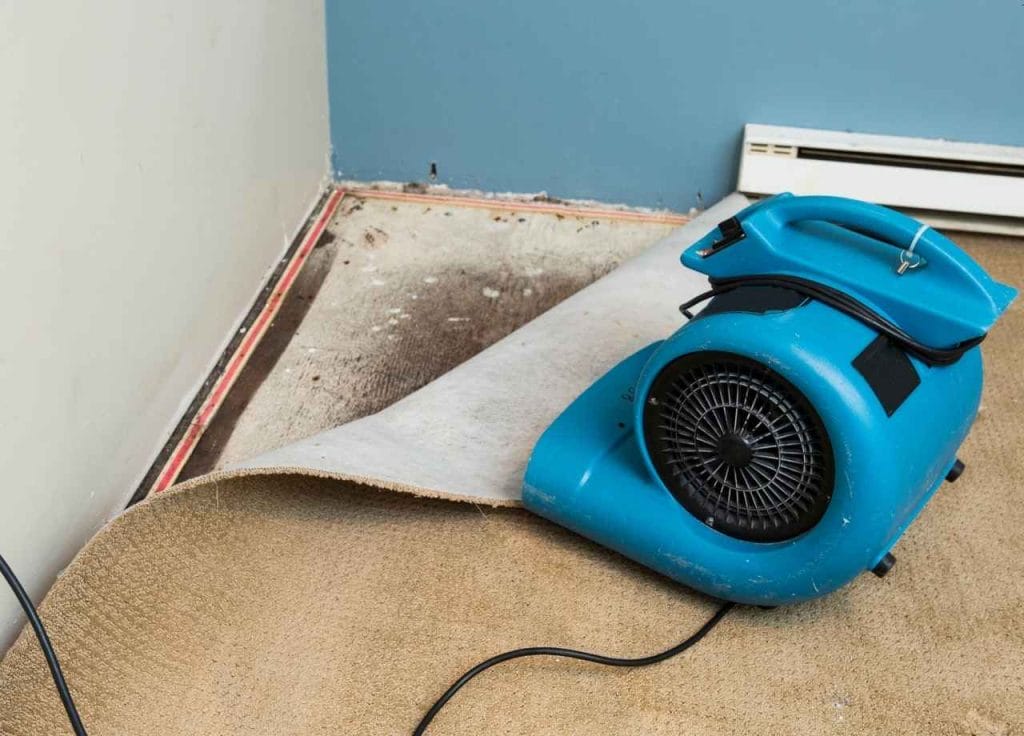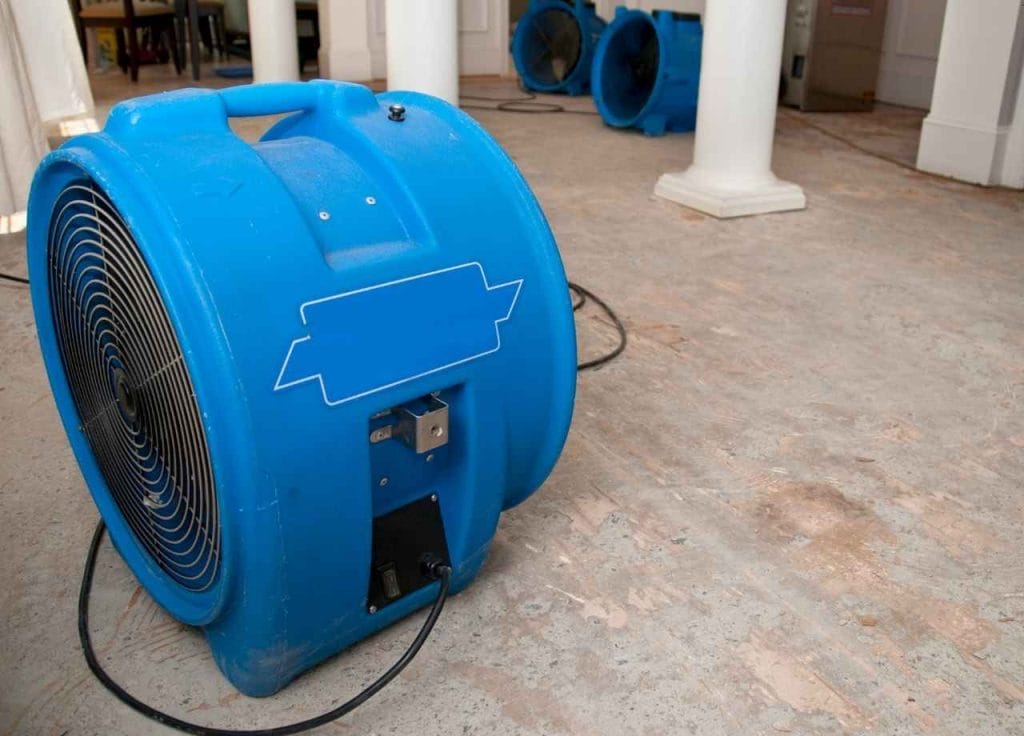Water damage can quickly spiral into a larger issue if not addressed correctly and promptly. Whether from a burst pipe, roof leak, or flooding, standing water and residual moisture create the ideal conditions for structural deterioration and mold growth. One of the most common steps in the drying process is using fans. But how long should they run? And are they actually effective in accelerating the recovery process?
At First Coast Contracting, we’ve spent decades restoring homes and properties across Jacksonville and St. Augustine after water disasters. We’ve seen firsthand how proper airflow can make or break a recovery timeline. Here’s what every homeowner should know about using fans after water damage.
Table of Contents
Why Airflow Matters After Water Damage
Once the source of water intrusion is stopped and the bulk of the water is removed, what remains is hidden moisture trapped in floors, walls, insulation, subfloors, and even structural framing. Left unattended, this moisture leads to swelling, warping, musty odors, and mold within as little as 24 to 48 hours.

Airflow plays a major role in helping moisture escape from building materials. By constantly moving air over damp surfaces, fans promote evaporation. However, it’s not just about placing a few fans randomly and walking away. The type of fan, its position, and how long it runs all influence how fast the structure dries.
How Long Should You Run Fans?
There is no one-size-fits-all answer. The time fans need to run depends on:
- The severity and type of water damage (clean water vs. gray or black water)
- The building materials involved (hardwood, carpet, drywall, insulation, etc.)
- Temperature and humidity levels
- How quickly mitigation efforts began
- Type and number of fans being used
In most residential water damage cases, fans should run for at least 24 to 48 hours, but it’s often necessary to run them for three to five full days, especially if moisture has penetrated walls or flooring systems.
In cases involving saturated drywall, hardwood, or subflooring, drying may take five to seven days or more. Fans may need to run continuously, 24 hours a day, during this period. Interrupting airflow slows the process and gives mold a chance to take hold.
Using the Right Equipment Makes a Difference
Not all fans are built for structural drying. Standard household fans have limited power and airflow range. In a professional setting, high-velocity axial or centrifugal air movers are used. These fans move large volumes of air across surfaces, significantly increasing evaporation rates.
When paired with commercial-grade dehumidifiers, this combination pulls moisture from the air as it’s released from wet materials. Without proper dehumidification, moisture stays in the air and can re-condense on cooler surfaces, leading to secondary damage.
Where and How Fans Should Be Placed
Placement strategy is just as important as how long fans run. To maximize drying:
- Direct airflow across wet surfaces, not just into the open room.
- Aim fans at a 45-degree angle to surfaces for even coverage.
- Use enough air movers to create a consistent cross-current in the room.
- In wall cavity drying, fans or injectidry systems may be required to force air behind baseboards and into hidden spaces.
- If flooring like hardwood or tile has been lifted, fans should be placed to dry the underside and subfloor.
Every situation is unique. In larger water losses, fan placement will change daily as materials dry unevenly. Regular moisture readings help identify when and where to reposition equipment.
Temperature and Humidity Control Matters
Evaporation alone isn’t enough. Once moisture enters the air, it needs to be removed. Otherwise, high humidity slows down drying and encourages mold growth. That’s why fans must be paired with dehumidifiers—especially in Florida’s humid climate.
Ideal drying conditions include:
- Indoor temperature between 70-90°F
- Relative humidity kept below 50%
- Closed windows and doors to prevent introducing more humid air
Running HVAC systems can help maintain temperature, but too much airflow from vents can interfere with targeted drying efforts. A trained technician can balance these factors for optimal results.
When to Turn Off the Fans
The only reliable way to know when it’s safe to stop using fans is with a moisture meter or thermal imaging equipment. Drying is not about how the surface feels—it’s about what’s happening beneath.

Even if floors or walls feel dry to the touch, hidden pockets of moisture may still exist. Shutting down fans too early increases the risk of mold, wood rot, and long-term odor problems.
Most professionals use moisture mapping and daily readings to track progress. When all materials have returned to their target dry standard—usually matching unaffected areas of the home—fans can be safely removed.
DIY vs. Professional Drying: What’s at Stake?
Homeowners can handle minor spills or limited water intrusion with a few well-placed fans and a household dehumidifier. But when water saturates walls, ceilings, or flooring, the drying process becomes more complex.
A professional restoration team uses calibrated tools, drying plans, and proven equipment to ensure complete moisture removal. This is especially important when filing an insurance claim. Incomplete drying can lead to denial of future claims if additional damage occurs.
Failing to dry the structure properly not only costs more down the line—it can affect the safety and value of your home.
Final Thoughts
Fans absolutely speed up the recovery process after water damage, but only when used correctly and in the right conditions. The drying period usually lasts between three to seven days, sometimes longer depending on materials and moisture levels. Simply running fans for a day or two and assuming the job is done often leads to costly surprises later.
At First Coast Contracting, we treat every water loss as time-sensitive. With the right approach, our goal is to restore your home safely, efficiently, and without cutting corners. Whether you’re dealing with a recent leak or the aftermath of a major flood, understanding the role of airflow and fan use is a crucial part of recovery.



One Response
Really clear and practical post—thanks for laying out how airflow can truly make or break the drying process after water damage. I’ve always heard “just run fans,” but your advice—running them for at least 24–48 hours and up to 3–5 days (or even 5–7 days for deeply saturated areas like hardwood or drywall)—makes a lot of sense. The reminder that positioning, temperature, humidity, and knowing the type of water damage all affect drying time adds depth I’ve needed. I recently dealt with a leak behind wood flooring, and this kind of breakdown would’ve helped me set a better timeline from the start!